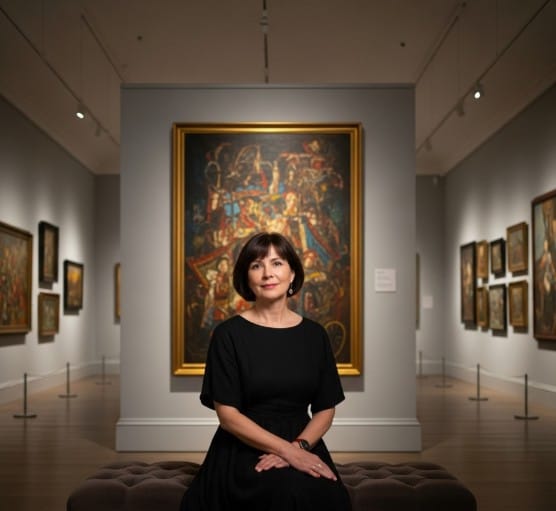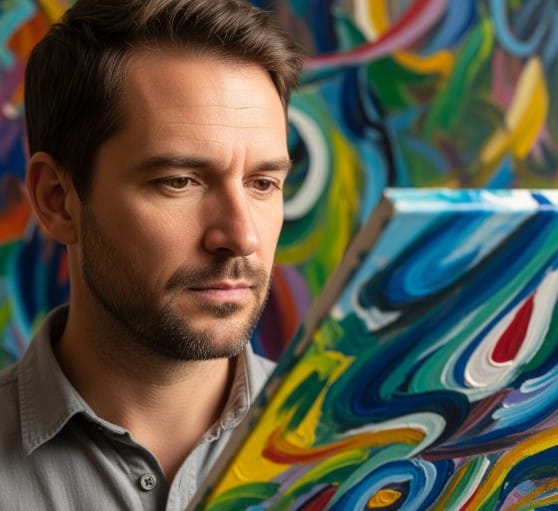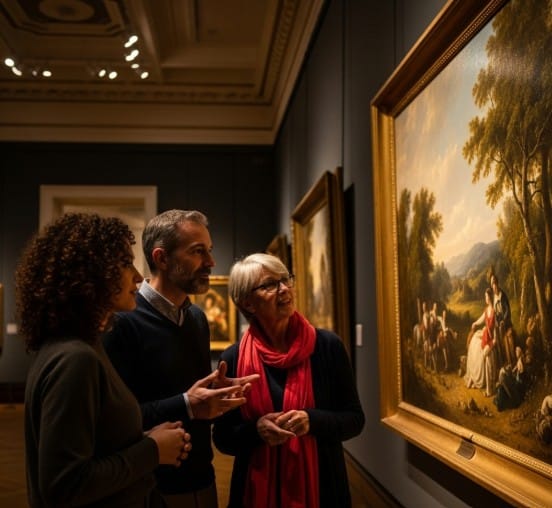The Benefits of Art Appreciation for Mental Health
Introduction
In an increasingly chaotic world, where stress, anxiety, and burnout have become part of our daily vocabulary, people are turning toward new ways to find peace and clarity. Among these, art appreciation stands out as a simple yet profoundly transformative practice. You don’t need to be a professional artist or an art historian to benefit from it. All it takes is a willingness to observe, feel, and connect.
Scientific research and personal testimonies alike confirm what humanity has known for centuries: art heals. Whether you’re gazing at a serene landscape painting, wandering through a sculpture gallery, or admiring digital art on your phone, the impact on your mental well-being is real and measurable.

Understanding Art Appreciation
Art appreciation is more than just looking at paintings or sculptures. It involves engaging with a piece of artwork intellectually, emotionally, and even spiritually. It requires us to slow down, observe the details, consider the artist’s intention, and reflect on our own response. This process creates a bridge between the outside world and our inner thoughts and emotions.
Unlike creating art—which involves tools, techniques, and practice—appreciating art is accessible to everyone. Whether in a museum, online gallery, or your own home, anyone can pause to appreciate an image and allow it to speak to them.
The Science Behind Art and Mental Health
Modern neuroscience has provided fascinating insights into how art affects the brain. When we engage with visual art, multiple areas of the brain are activated, including those responsible for emotion, memory, and self-reflection. Viewing art can trigger the release of dopamine, a neurotransmitter associated with pleasure and motivation.
A 2019 study published in Frontiers in Psychology found that art observation reduced levels of cortisol, the hormone associated with stress. Similarly, exposure to art has been shown to improve mood, enhance cognitive function, and increase empathy.
Art activates both hemispheres of the brain—the right, which deals with emotions and imagination, and the left, which handles logic and analysis. This dual engagement leads to a state of mental equilibrium, offering both stimulation and calm.

Art Appreciation and Stress Reduction
One of the most immediate benefits of art appreciation is stress relief. When we take time to engage with a work of art, our heart rate slows, breathing becomes deeper, and the mind starts to quiet down. The simple act of looking at something beautiful or thought-provoking can shift our focus away from worries and into a moment of mindfulness.
This is especially beneficial in today’s fast-paced digital culture. Art offers a pause—a moment of reflection and rest. It is a gentle, meditative practice that doesn’t require effort but offers immense reward.
Imagine walking into a quiet room, where a single canvas hangs on the wall. You stand before it, noticing the brush strokes, the play of light, the mood it conveys. That moment is yours. It is uninterrupted, sacred, and healing.
Building Emotional Intelligence through Art
Art has a unique way of helping us explore complex emotions. Whether we feel joy, sadness, confusion, or nostalgia while viewing a piece, art gives us permission to feel deeply without judgment. It invites us to connect with universal human experiences, making us more emotionally aware and empathetic.
This is particularly helpful for individuals who struggle with expressing their feelings. Through art appreciation, we learn the language of emotion. We begin to recognize our own responses and gain insight into others’ perspectives.
Art also provides a safe outlet for emotional processing. Looking at a sorrowful painting might help someone release pent-up grief. A vibrant abstract might uplift a depressive mood. Over time, these experiences build resilience and emotional flexibility.

Enhancing Focus and Mindfulness
In a world driven by notifications and multitasking, our attention spans are shrinking. Art appreciation, however, is an exercise in focus. It requires patience, presence, and observation. When we immerse ourselves in artwork—really noticing the details, textures, composition, and symbolism—we enter a state of mindfulness.
Mindfulness is the practice of being fully present in the moment, and it’s been shown to reduce symptoms of anxiety, depression, and chronic stress. Art appreciation naturally fosters this state without requiring structured meditation or yoga. It becomes a quiet ritual—an anchor amid the noise.
Many mental health professionals even incorporate art observation into mindfulness-based therapy. Some museums now offer “slow looking” sessions, encouraging visitors to spend 10–15 minutes with a single artwork. The result? A deeper connection and a greater sense of inner calm.
Connection and Belonging through Shared Art Experiences
Appreciating art isn’t always a solitary act. In fact, discussing art with others can be a powerful way to connect. Group gallery visits, art clubs, or online forums offer a sense of community around shared interests.
These conversations often lead to meaningful exchanges of ideas and feelings, helping combat loneliness—a major contributor to poor mental health. When we talk about art, we reveal something about ourselves. We build bridges through personal interpretations, cultural references, and emotional reactions.
Even virtual art tours or social media-based art groups can foster this sense of belonging. The global art community is rich, diverse, and open to all—regardless of age, background, or expertise.

Art as a Mirror for Self-Reflection
Sometimes, the art we are drawn to says more about us than the artist. Our preferences, reactions, and interpretations reveal our subconscious thoughts, unresolved emotions, and hidden desires. In this way, art becomes a mirror—a tool for introspection.
Self-reflection is an essential component of good mental health. It helps us understand our motivations, make better decisions, and align our lives with our values. Art appreciation fosters this process in a gentle and non-invasive way.
Keeping a journal alongside your art-viewing experience can deepen this practice. Write about how a painting made you feel, what memories it evoked, or what questions it raised. Over time, you may notice patterns or discover new insights about yourself.
Harvard Health – How Art Can Improve Mental Health
Art in Healing Environments
Hospitals, rehabilitation centers, and therapy clinics are increasingly incorporating art into their design and programs. Research shows that patients recover faster and experience less pain when surrounded by visual art.
Paintings and murals in waiting areas reduce anxiety. Art therapy sessions help individuals express trauma that may be difficult to verbalize. Even viewing nature photography in a clinical setting can lower blood pressure and promote relaxation.
This integration reflects a broader recognition that healing is holistic. Our environments matter. The colors, textures, and images we surround ourselves with influence our emotional state. Through intentional art placement and guided appreciation, even institutional spaces can become sanctuaries.
Children and the Importance of Early Art Exposure
Children benefit immensely from exposure to art, not only in terms of creativity but also mental well-being. Art helps children process feelings, develop empathy, and gain confidence. Observing and discussing art sharpens their communication skills and emotional vocabulary.
Museums and educational programs that encourage art appreciation at a young age plant the seeds for lifelong mental resilience. Parents can start at home by showing children a variety of art styles and encouraging open-ended conversations: “What do you see? How does this make you feel?”
Incorporating art into school curriculums isn’t just about developing future artists. It’s about raising emotionally intelligent, curious, and mindful individuals.

Digital Access: Art for All
The digital revolution has made art appreciation more accessible than ever. You don’t need to live near a museum to experience great art. Websites like Google Arts & Culture, The Met, and MoMA offer free virtual tours, high-resolution images, and curated collections.
Social media platforms like Instagram and Pinterest expose millions to contemporary artists and timeless masterpieces daily. With just a few taps, you can fill your feed with beauty, thought, and emotional richness.
This accessibility democratizes mental health benefits as well. No matter your location, income, or background, you can experience the mental uplift that comes from engaging with visual art.
How ISKUSS Encourages Mindful Art Engagement
At ISKUSS, we believe that art is not just a commodity—it’s an experience. Our curated collection of premium artworks is designed to do more than decorate a space. Each piece is rooted in cultural depth and crafted to evoke thought, emotion, and connection.
Whether you are a seasoned collector or a first-time viewer, our platform invites you to slow down and engage deeply. We encourage storytelling, reflection, and appreciation as part of the art-buying journey.
Art can be a personal sanctuary, a portal to another world, or a quiet companion in times of stress. At ISKUSS, we honor that power and invite you to explore it for yourself.
Explore meaningful artwork at ISKUSS and experience the emotional richness of mindful art appreciation.
Conclusion: Making Space for Art in Everyday Life
Incorporating art appreciation into your daily routine doesn’t require grand gestures. Spend five minutes a day looking at a painting online. Visit a gallery on weekends. Pause at a mural you pass on your commute. Let art be part of your rhythm.
The benefits are cumulative. Over time, you’ll find yourself more centered, emotionally aware, and connected—to yourself and the world around you.
Art appreciation is a simple but powerful practice. It opens the door to healing, mindfulness, and joy. And in a world that often demands more than we can give, that is no small gift.

